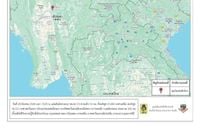On March 28, 2025, a powerful earthquake measuring 7.4 on the Richter scale struck near Pang Mapha District, Mae Hong Son Province, Thailand, sending shockwaves felt as far as Bangkok and surrounding areas. The earthquake's epicenter was located at a latitude of 21.682 degrees North and a longitude of 96.121 degrees East, approximately 326 kilometers northwest of Pang Mapha.
The Department of Disaster Prevention and Mitigation (DPM) acted swiftly in response to the earthquake, advising citizens on safety measures during seismic events. Mr. Phaskorn Bunyalaksman, the Director-General of the DPM, emphasized the importance of the "Mop - Pong - Kao" method, which encourages individuals to crouch under sturdy furniture, protect their heads, and evacuate tall buildings promptly. He urged the public to remain calm and check on the safety of those around them after the shaking subsided.
As reports of damage began to surface, it became clear that the earthquake had caused significant destruction. A construction site in Bangkok was particularly hard-hit, where a building collapsed, trapping approximately 300 workers inside. Eyewitness accounts and videos shared on social media, particularly by the Facebook page "Fire & Rescue Thailand," depicted harrowing scenes of workers calling for help from beneath the rubble.
At around 14:40, rescue operations commenced as emergency services rushed to the scene. The situation remained dire, with many workers unaccounted for. The DPM coordinated with local authorities to monitor the situation closely and provide assistance to those affected.
In addition to the earthquake, reports of forest fires have emerged, affecting approximately 7.7 million rai across several provinces, including Bangkok. The DPM is also addressing these fires, which have been exacerbated by the earthquake. They are establishing firebreaks and urging residents to refrain from burning debris, which could further ignite the already tense situation.
As part of their disaster response, the DPM is setting up a command center to streamline assistance efforts. They are requesting that citizens stay informed through official channels and report any emergencies via the 1784 hotline, available 24 hours a day.
In another incident on the same day, a construction worker named Mr. Kiattisak fell into a six-meter deep sewage pit while working in Nonthaburi Province. Emergency services were alerted at 08:30 AM, and rescue teams quickly arrived to assist. Kiattisak was found lying at the bottom of the pit, having suffered injuries. He was safely extracted and transported to a local hospital for treatment.
The DPM reiterated the significance of adhering to safety protocols during such disasters and encouraged individuals to remain vigilant. They are also conducting inspections to assess the damage and ensure that all safety measures are in place for future incidents.
The earthquake's impact has raised concerns about building safety standards in the region, particularly for structures under construction. As authorities investigate the causes of the collapse and the overall response to the earthquake, there is a growing call for stricter regulations to prevent similar tragedies.
In light of these events, the DPM has been proactive in disseminating information to the public, aiming to alleviate fears and provide clear guidance on what to do in the aftermath of such disasters. They are also working closely with local governments to ensure that assistance reaches those in need.
As the situation continues to develop, officials are urging residents to stay alert and to follow updates from the government regarding safety measures and assistance programs. The DPM is committed to addressing the needs of those affected by both the earthquake and the forest fires, ensuring that communities receive the support they require.
The earthquake and its aftermath have highlighted the importance of disaster preparedness and community resilience. As Thailand faces these challenges, the collective response from the government, emergency services, and citizens will be crucial in navigating the recovery process.



